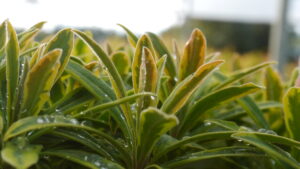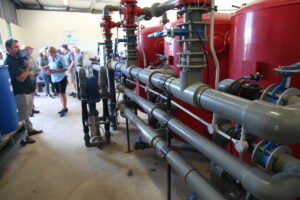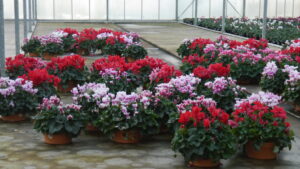
Irrigation is about control … and management
By John Fitzsimmons –
It’s a given that water is essential for production nurseries, precious, and sometimes expensive. It’s also a fact that your plants need enough water – not too much and not too little – at appropriate times and delivered in appropriate forms. Compatibility of greenlife, growing operations, hardware, business and water management is essential.
There are many areas of work and industry where different yet complementary skills and resources must dovetail effectively for success. In the greenlife industry, few are more universal or important as irrigation which involves both the plants and the water supply/application. It is rare (not impossible) to find a horticulturist who is also a good (and qualified) plumber or hydraulics engineer and vice versa.

The understanding and working arrangements between the two sides must be defined and agreed along the way. Could do, should do, must do and did can be four separate thoughts depending on your perspective. So, when you next need an irrigation upgrade or new installation, here is something of a checklist. Disclaimer – general in nature and highly likely to be incomplete for any one project!
Water source
Where is the water sourced from – town supply, dam, bore, stream etc.
Water volume/pressure available/needed
What volume of water, at what pressure, is available/needed daily, monthly, yearly? Does the volume available and flow rate vary through the year/season? Is the supply reliable, dependable? Is a back-up supply or source needed? Could the supply be subject to restrictions under different seasonal or supply conditions?
Water quality
There are many aspects of water quality including pH, chemical contaminants, physical contaminants etc. These may affect the irrigation system’s ability to function and/or the viability of the plants
- Obtain a competent and suitable laboratory analysis*
- Regularly monitor water quality*
- If remediation or treatment is needed, how will this be done? Will the treated water be safe for your plants? For the irrigation system including pumps and valves?
(*these are usually normal checks in Quality Assurance [QA] programs)
Water ownership
The water may knowingly or unknowingly be sourced from another property or originate from an unauthorised supply. Is it from an allocation of flows ‘owned’ by another entity? It does pay to check.
Water cost
What are the ultimate costs associated with the water supply/supplied? What is the price? Are there licence, delivery or tapping fees as well? What are the expected running costs (e.g. electricity)? Even if the water ‘input’ is ‘free’ what is the capital cost of treating it? Storing it (e.g. tanks, dam) Etc.?

System design
Exactly what are the needs of your site and your plants – in total and or by section? This will require consideration of the species grown, stage of growth, growing system (pots, bags, in-ground, hydroponic etc.), container type and size, plant and/or container spacings, potting mix characteristics (water-holding, drainage) etc.
It will also need to take into account any relevant regulatory guidelines or factors regarding conduits, connections, etc. (e.g. Australian Standards, backflow prevention).
System performance
Agreements, contracts and tenders for the design, supply and installation of irrigation systems should reference the key performance parameters expected by the client. As an example, referencing Best Practice Guidelines for Functional Open Space** suggests the available water supply should “have sufficient capacity (flow and pressure) to deliver a minimum of 35mm of watering across all irrigated areas within a 7day period, with an allowable watering window of eight hours while adhering to all current water restrictions”.
**Open space is any open piece of land that has largely no buildings or other built structures and is accessible to the public. Green open space can include, green space (land that is partly or completely covered with grass, trees, shrubs, or other vegetation, including parks, community gardens, cemeteries), school yards, playgrounds, public areas, sports fields, golf courses, streetscapes.
Especially if mains connected, the system should have a zone backflow prevention device suitably specified for the task and complying with Australian plumbing regulations. A containment protection device may also be required downstream of the water meter (where applicable).

Systems utilising dripline should use pressure compensating lines, incorporate vacuum breakers and provide for manual flushing. Specs should also detail pinning intervals and minimum soil cover depth (if applicable).
Where pop-up sprinklers are used, the minimum clearance below the Finished Surface Level should be noted, and any needs for built-in drain devices or pressure regulation included.
Materials
In most cases there are Australian Standards covering lines and connections, joining and installation.
Valves
There are many different types of valves and directors that can be specified. There are usually Standards and conventions for their selection (e.g. to suit water quality), installation, settings and identification.
Irrigation control
This has become quite a specialised matter and the best advice should be sought as to type, make and model of equipment used, and the most appropriate linkage, connection, installation, and network hubs used. Just some of the matters to consider include:
- Which control software? PC or cloud-based? Who is responsible for the IT hardware and connections or licence fees? The data requirements?
- The incorporation of flow sensor/s.
- Settings for local weather/seasonal patterns. Integration with local weather station/s.
- Power backup supply.
- Site and location including access, enclosures (weather and vandal-proof), etc.
- The type of cable and cable joiners (where used) should be specified and detailed for each project.
Protections
The project should involve a Certified Irrigation Designer, a Certified Irrigation Contractor or Installer, and Licenced by the appropriate State authority (where applicable). Contractors should hold insurance cover/s for Workcover or equivalent, $5 million of Professional Indemnity, and $20m of Public Liability.
More information: https://waterportal.com.au/swf/images/swf-files/bpg-final.pdf
